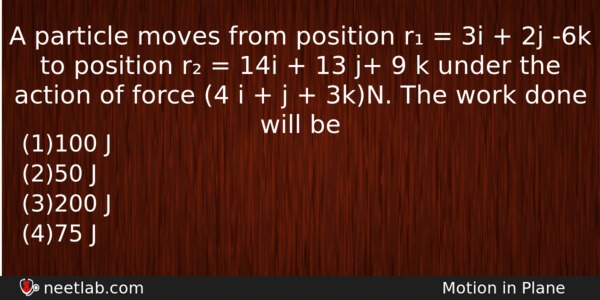| ⇦ | 
| ⇨ |
A particle moves from position r₁ = 3i + 2j -6k to position r₂ = 14i + 13 j+ 9 k under the action of force (4 i + j + 3k)N. The work done will be
Options
(a) 100 J
(b) 50 J
(c) 200 J
(d) 75 J
Correct Answer:
100 J
Explanation:
No explanation available. Be the first to write the explanation for this question by commenting below.
Related Questions: - A parallel plate capacitor has 91 plates, all are identical and arranged with same
- The mean free path of molecules of a gas,(radius ‘r’) is inversely proportional to
- Newton postulated his corpuscular theory on the basis of
- A photon of wavelength 300nm interacts with a stationary hydrogen atom in ground
- A particle is executing SHM along a straight line. Its velocities at distances
Topics: Motion in Plane
(93)
Subject: Physics
(2479)
Important MCQs Based on Medical Entrance Examinations To Improve Your NEET Score
- A parallel plate capacitor has 91 plates, all are identical and arranged with same
- The mean free path of molecules of a gas,(radius ‘r’) is inversely proportional to
- Newton postulated his corpuscular theory on the basis of
- A photon of wavelength 300nm interacts with a stationary hydrogen atom in ground
- A particle is executing SHM along a straight line. Its velocities at distances
Topics: Motion in Plane (93)
Subject: Physics (2479)
Important MCQs Based on Medical Entrance Examinations To Improve Your NEET Score
18000+ students are using NEETLab to improve their score. What about you?
Solve Previous Year MCQs, Mock Tests, Topicwise Practice Tests, Identify Weak Topics, Formula Flash cards and much more is available in NEETLab Android App to improve your NEET score.
Share this page with your friends

Leave a Reply